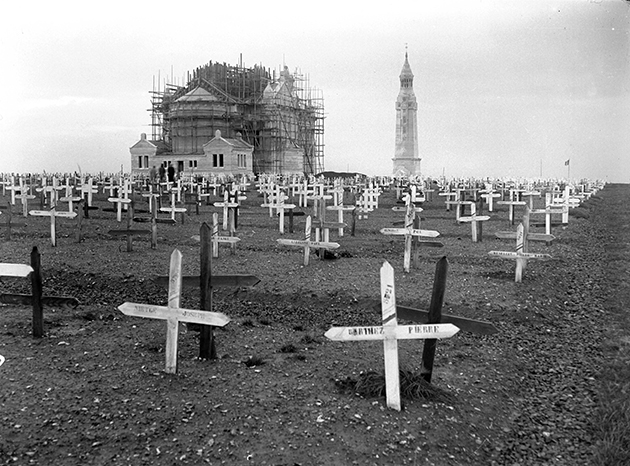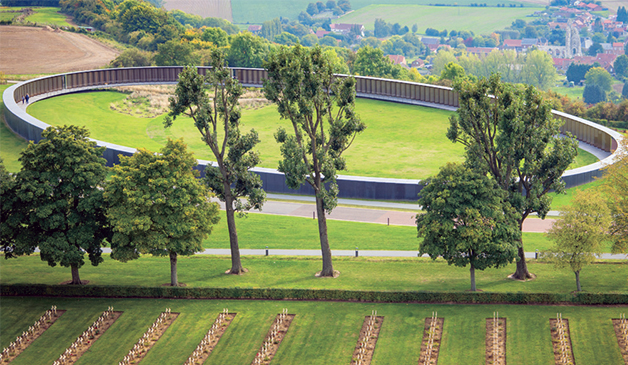Remembering the poilus: Notre Dame de Lorette

After the First World War, the scars of the fighting on the hill of Notre Dame de Lorette were erased from the surrounding landscape but, a century on, France’s largest military cemetery, the monument and the international memorial stand out as a site of remembrance, tribute and commemoration.

The basilica, under construction, and the lantern tower, at the centre of Notre Dame de Lorette cemetery, 1928. © Roger-Viollet
The hill of Notre Dame de Lorette, located in the commune of Ablain-Saint Nazaire, in Pas-de-Calais, rises to a height of 168 metres. It marks the northern limit of the Artois plateau and dominates the Gohelle plain which, in 1914, was France’s principal mining area. This strategic site was occupied by the German army on 5 October 1914, during fighting in the “Race to the Sea”. The belligerents soon dug networks of trenches on the hillside, ravaged by artillery fire. Fighting went on there intermittently for six months, until the major French offensive of the Second Battle of Artois, launched on 9 May 1915. After some terrible fighting, the front was established at the foot of the hill to the east, in the village of Souchez, in the Third Battle of Artois, in late September. In March 1916, replacing the French who had gone to fight in Verdun, the British took control of the front, which remained stable until 1917.
By 1915, a number of temporary cemeteries had been built on the hill, and a small oratory was installed in the ruins of the chapel of Notre Dame de Lorette in 1916. Founded on 25 November 1918, the Office of Military Graves designed huge “concentration” cemeteries, standardised and austere; the site of Notre Dame de Lorette was chosen for the Flanders and Artois fronts, and officially became a national cemetery by presidential decree on 16 January 1924.
Containing the bodies from nearly 150 temporary cemeteries across Belgian Flanders and Artois, the national cemetery occupies an area of 13 hectares; it forms a rectangle, cut across by two wide avenues. Nearly 43 000 bodies are buried there, including 22 970 unknown soldiers in eight ossuaries. In the middle of the cemetery is a large esplanade, where the official ceremonies are held, around a flame of remembrance. A Jewish section (48 steles) and a Muslim section (555 graves) were built in the 1930s, in the west of the cemetery; these were desecrated several times between 2000 and 2010.
In 1919, a group of important figures – including the Bishop of Arras, Monseigneur Julien; Charles Jonnart, chief executive of the Pas-de-Calais department; and the managing directors of a number of mining companies – set up an organisation to make the hill of Notre Dame de Lorette a key First World War remembrance site, by erecting a memorial there to the soldiers killed in Artois and Flanders. The memorial was commissioned from Lille architect Louis-Marie Cordonnier, who, after several drafts, opted for the construction of a basilica and lantern tower in the centre of the national cemetery. The 52-metre-tall lantern tower was erected over one of the ossuaries; the crypt at the foot of the tower was to hold the bodies of unknown soldiers killed in the wars of the 20th century in which France was involved, together with an urn containing the ashes of deportees who died in the Nazi concentration camps. The neo-Byzantine basilica has an unusual west-facing apse. Most of its stained-glass windows depict religious and patriotic scenes from French history, but six pay tribute to British Imperial combatants. The walls of the nave are covered with hundreds of ex-voto plaques in memory of the French soldiers killed in the Great War. The presence of these two monuments validates a double pilgrimage, both patriotic and Catholic, resulting from the realignment of the French Church with the Republic at the beginning of the First World War. Most of the signs of the fighting were erased after the conflict, and farmland and woods took over the landscape once more.

The Ring of Remembrance, Memorial of Notre Dame de Lorette. © E. Rabot/SGA/COM
After the Second World War, Notre Dame de Lorette was practically erased from the national memory of the First World War, which turned its attention to Verdun. In 2014, the national cemetery was included among the nine “Major National Remembrance Sites” of the Ministry of the Armed Forces. The same year, the construction of an international memorial, on the initiative of the Nord-Pas-de-Calais region, saved the site from oblivion. The memorial was part of an agreement signed in 2011 between the Ministry of Defence and the regional authority to redevelop and promote the Notre Dame de Lorette site in the context of the First World War centenary. Designed by architect Philippe Prost, this superb monument, unveiled by the French president on 11 November 2014, has won a number of French and international architecture awards. An ellipse with a circumference of 345 metres set on the edge of the hillside, it is comprised of 500 steel plates bearing the names of 580 000 soldiers killed in French Flanders and Artois between 1914 and 1918. They are listed in alphabetical order, without distinction of rank, nationality or religion, friends and enemies of yesterday united in a kind of posthumous comradeship. Spontaneously nicknamed the Ring of Remembrance by the throngs of people who have since visited it, the monument marks a profound change in the approach to remembrance, which, for the first time, was not limited to the national context, and thus contributed to bringing peace to First World War remembrance. At a glance, it throws into relief the mass death that characterised the Great War, while at the same time giving a place to the fate of each individual.
Yves Le Maner, history teacher and member of the scientific committee of the First World War Centenary Mission

